A Product from a Merchant Who Issued and Made Civil War Tokens
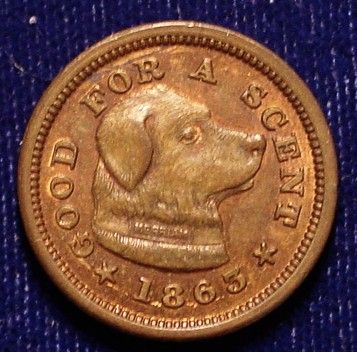
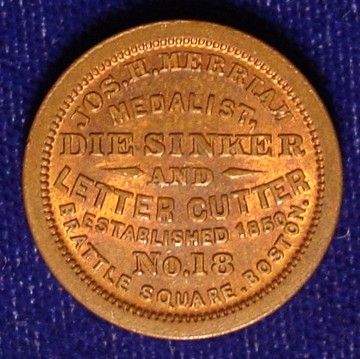
The "Good for Scent" token by Joseph Merriam has become an iconic piece in the Civil War token series. It is a bit of 19th century humor that still draws a smile. Another of Merriam's tokens, the salamander design Merriam & Co. issued might have been almost as iconic except for two factors. First, it is virtually unknown in any grade above EF, which is a big deal it today's quality obsessed market. Second, it is such are a rare piece that it seldom comes to the market. Estimates range at around 15 examples known.
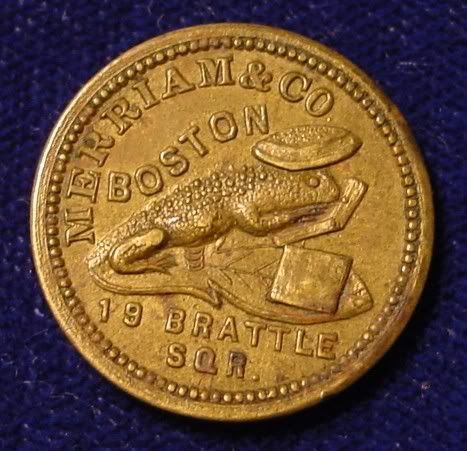
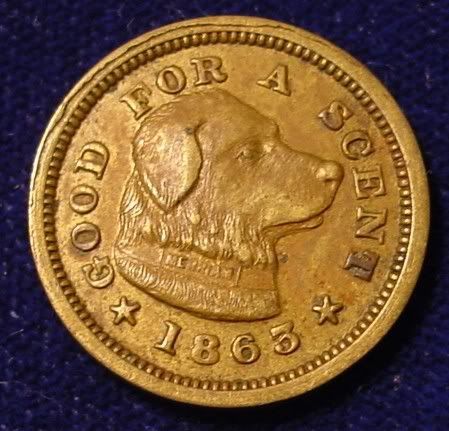
Recently one of Merriam's paper presses cropped up in a Stack's Americana auction. The bidding history on this sorted so I won't get into it, but one of the interested parties allowed to me buy it for which I am very grateful. It is not a salamander press, but it does feature the "king of beasts." It is signed below the lion's mouth as, "JH Merriam Manuf'r / 18 Brattle Square Boston." This is the first and only product I have ever owned that was made by merchant who issued a Civil War store card that advertised their business. It is not a salamander press, if one still exists, but it is still a neat item. The estimates are that this piece was made sometime in the period between 1869 and 1872.
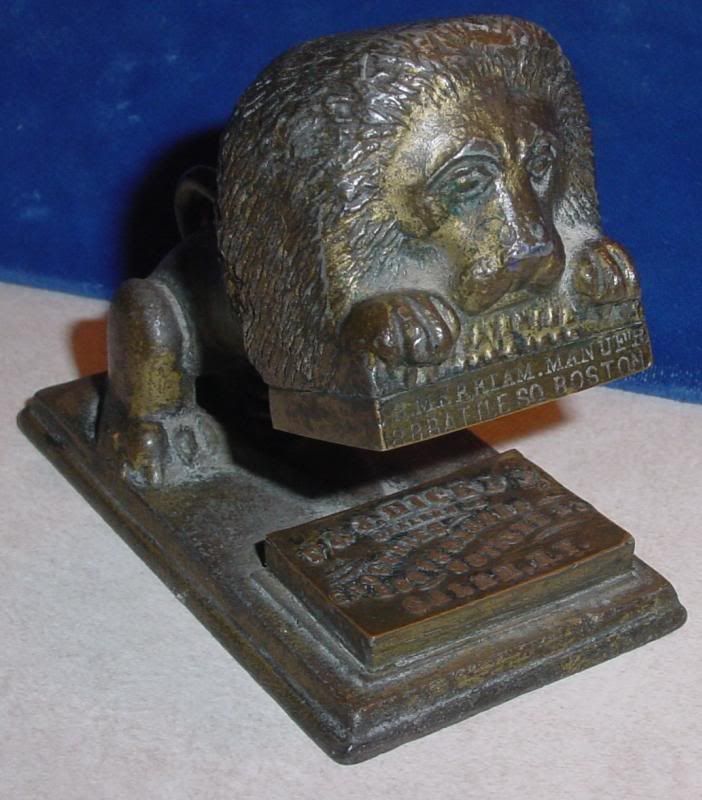
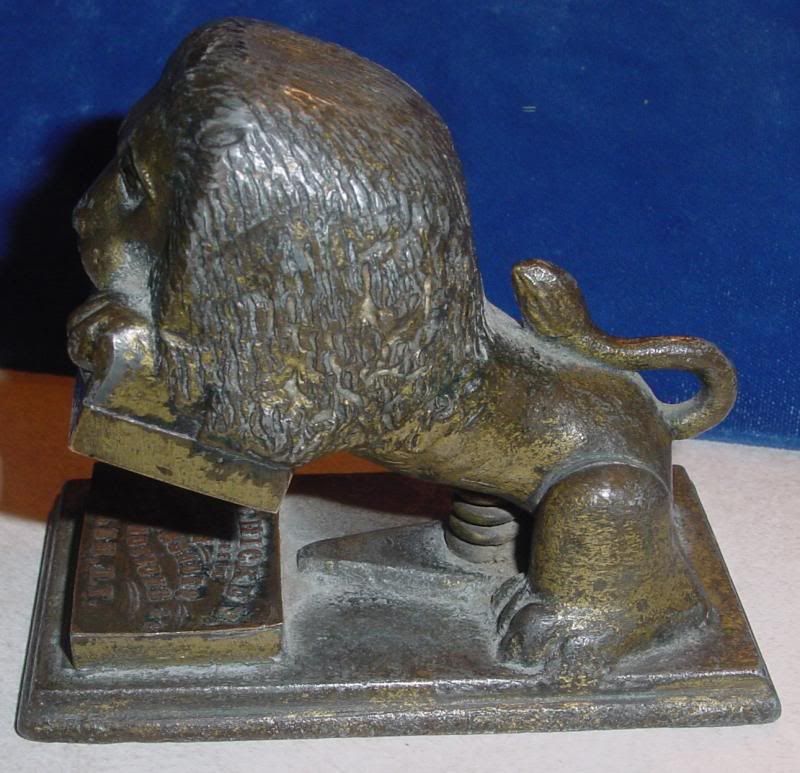
Retired dealer and avid collector of U.S. type coins, 19th century presidential campaign medalets and selected medals. In recent years I have been working on a set of British coins - at least one coin from each king or queen who issued pieces that are collectible. I am also collecting at least one coin for each Roman emperor from Julius Caesar to ... ?
9
Comments
What plate is in the press? Do you have a copy of an actual paper product that is associated with your lion press? Very cool.
<< <i>What plate is in the press? Do you have a copy of an actual paper product that is associated with your lion press? Very cool. >>
No I don't. I'd hate to press on it make one and break the spring although it seems to be in good shape. I'll see if I can take a picture and then go for the mirror image option.
Can the plates be changed to create new cards? It looks like everything is solid and not interchangeable.
Congratulations on acquiring an interesting and historical item that can be linked back to numismatics.
That is one of the awesome things about being a collector...you can collect in any direction imaginable.
But I have to tell you that at least this particular press was not designed and made by Joseph Merriam.
It was patented and made by Robert B. Carsley of Boston and was merely used as an advertising venue by Merriam.
Here is the original Patent:
ROBERT B. CARSLEY, OF BOSTON, MASSACHUSETTS.
Design No. 3,363, dated February 9, 1869.
DESIGN FOR A CANCELLING- AND EMBOSSING-STAMP.
The Schedule referred to in these Letters Patent and making part of the same.
To all persons to whom these presents may come Beit known that I, ROBERT B. OARSLEY, of Boston, in the county of Suffolk,
and State of Massachusetts, have invented a new and ornamental Design for a Gancclling and Embossing-Stamp;
and I do hereby declare the same to be described as follows, reference being had to the accompanying drawings,
of which- Figure l is a side view,
and Figure 2, a front elevation of it.
In the said drawings- A is the base-plate, on which is a die-plate, B, and the hind legs of a lion are elevated in manner as shown.
The remainder of the lion, O, which, at the rump, is hinged to the hind legs, has the fore paws resting on another die-plate, D,
which projects from them in manner as exhibited, each of the two die-plates being of a rectangular shape.
The paws of the front legs project over the upper edge of the upper die-plate.
A spring, E, resting on a projection from the baseplate, extends up into a recess in the body of the lion,
and serves to raise the body into an inclined position, relatively to the base-plate.
The design in question is composed of the lion, the die, and bed-plates, arranged and formed as described and represented.
I claim the said design for a cancelling-stamp or press.
ROBERT B. OARSLEY, Witnesses:
R. H. EDDY, SAMUEL N. PIPER.
----------------------------------------------------------------------------
Here is a picture of another example without the Merriam info stamped on the front:
Carsley alo patented a Buffalo press in 1871:
And here is the Salamander (the site I got the picture from says it is actually a frog):
I think it more likely that Merriam was the die cutter for the dies that were in these presses and he advertized
that on the second token you show with the Salamander press.
All in all a very
QN
Go to Early United States Coins - to order the New "Early United States Half Dollar Vol. 1 / 1794-1807" book or the 1st new Bust Quarter book!
The plate on the piece reads:
"P & J. Hickey
dealers in
Groceries, boots & Shoes notions & C
Salem NY"
I am pretty sure it is New York although that part is a bit mushed. I looked up on the Internet, and there is an old town named Salem in New York.
With further research, it appears that Merriam did make seal presses, just not the Lion press you now own. Here is a link to a website with more info on Merriam and seal presses...
Merriam Eagle Press
QN
Go to Early United States Coins - to order the New "Early United States Half Dollar Vol. 1 / 1794-1807" book or the 1st new Bust Quarter book!
Here is a mirror image view of the stamp that is under the lion's paws.
I think that last press that they called a frog looks like a toad. It really doesn't look like the salamander press that is shown on the token.
Successful BST deals with mustangt and jesbroken. Now EVERYTHING is for sale.
see
http://norcalseals.weebly.com/
http://norcalseals.weebly.com/merriam-eagle-press-1865.html
Cheers
Sealcollector, thank you for clarifying, and also "welcome to the forum!"
I did visit your website, and other sites, but I am not 100% clear on the application of the presses. Do you have a link to an article and/or images of the items produced with the presses? Were they strictly for advertising purposes? How easy is it to remove the plates and set up a new arrangement with other plates? Just trying to understand the reason why merchants would have purchased these presses, and how they were used in the daily channels of commerce. Thanks
The cast iron lever and percussion seal presses were to emboss papers, (a raised seal) as in corporate, court, Masons, Order of the red men, Eastern Star, odd fellows, notaries, schools, etc. either to make their paper work sealed as official or officious. (these papers were then "under seal" and earlier ones were wax impressions from a one sided die") Between 1850 and 1930's anyone who was anyone had a seal press. Most were plain, earlier ones were popular lion heads, sea monsters etc. The process was one bought the press, had the upper brass plate engraved by a die sinker such as Merriam, and the press was turned upside-down and lead poured though the bottoms to conform with the upper die. (bottom Pour holes help date a press).
Every town had a small foundry back then, and currently each month or so another press is discovered. JH Merriam then his son? made, engraved and sold presses as did dozens of other merchants and companies. Merriam tokens or store cards were also made in shop, some original some muled. Shenkman had never seen the Toad press, there are about a dozen known. Clearly the "tail" is actually the toads appendage (foot) however in miniature as on the token, Shenkmen unwittingly declared it a salamander and boasted of a Merriam Salamander (in caps) advertisement. None exist, I have most if not all Merriam advertisements on my web-site. Further more he ripped off the same article published in 1905,
and I am shocked the numismatic community has not outed Shenkman.
Free free to ask any questions, cheers
Very cool item Bill.
Free free to ask any questions, cheers
Are both articles (1905 original and 1980 version) available online?
Also, BillJones' seal plate looks relatively large, and it was used for a grocery store. What would they grocers have stamped with the press? Flyers that they would hand out to customers, or was it for business and legal documents?
Between 1850 and 1930's anyone who was anyone had a seal press.
I am not "anyone" by any means, but I do have a seal press that I use for the purpose of my working library. However, it is not nearly as interesting and elegant as the old presses in this discussion.
I have posted the Numismatist 2 issues on my site, but also the 1905 numismatist journal Merriam can be found under Google book search on line free, I bought a copy of the 1980 num journal containing shenkmans plagiarism. It stunned me, considering Shenkmans reputation.
And you bring out the "every-man appeal" a of seal press, you work in a more elegant library with embossed book pages and an officious looking historical tool that most certainly looks like it belongs there.
all questions invited
Here's an ad indicating that Merriam did manufacture the Lion press. This is from @sealcollector's website:
http://norcalseals.weebly.com/merriam-eagle-press-1865.html
Lots of interesting information on these embossing tools today....Other than seeing them mentioned from time to time, I never really thought much about them. Now I want an Omega embossing tool... Why? Because no one seems to have one, or even a picture of one. That would be super cool... Cheers, RickO
Cheers, RickO
I found this discussion researching an odd little item I found in an old lap desk. It’s about 1.5” long and stamped J.H. Merriam. Is this the same man?